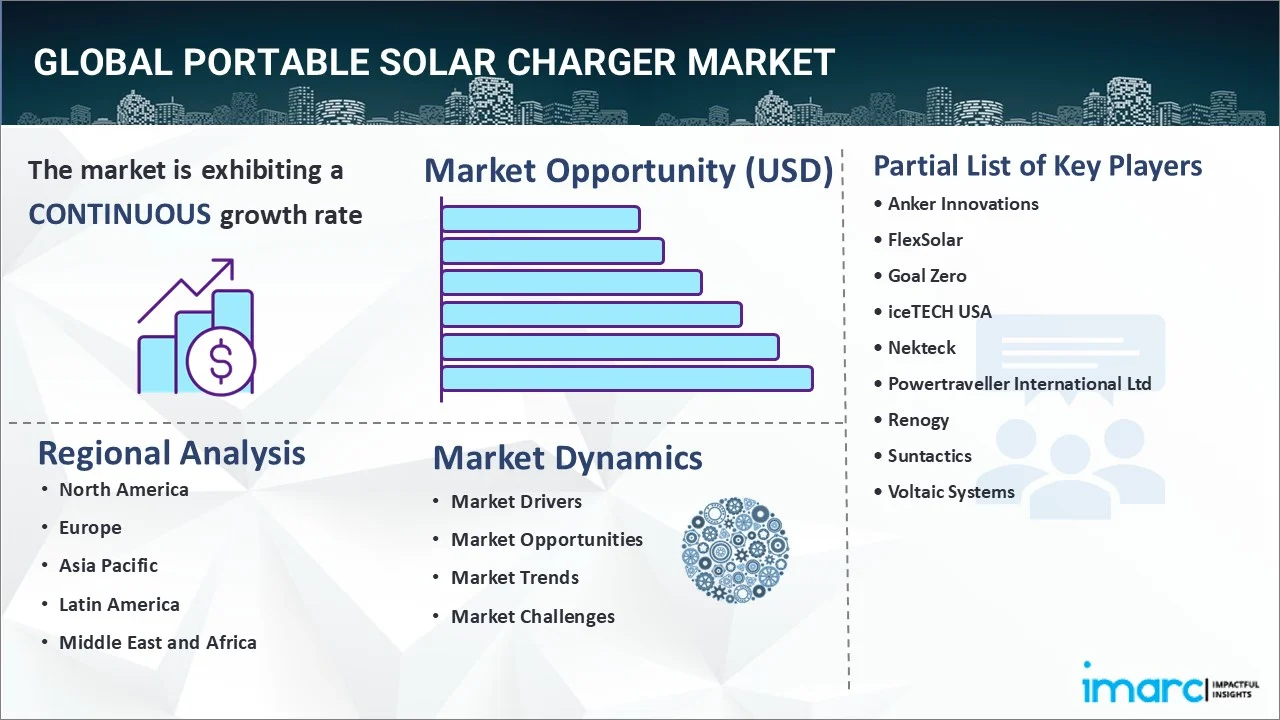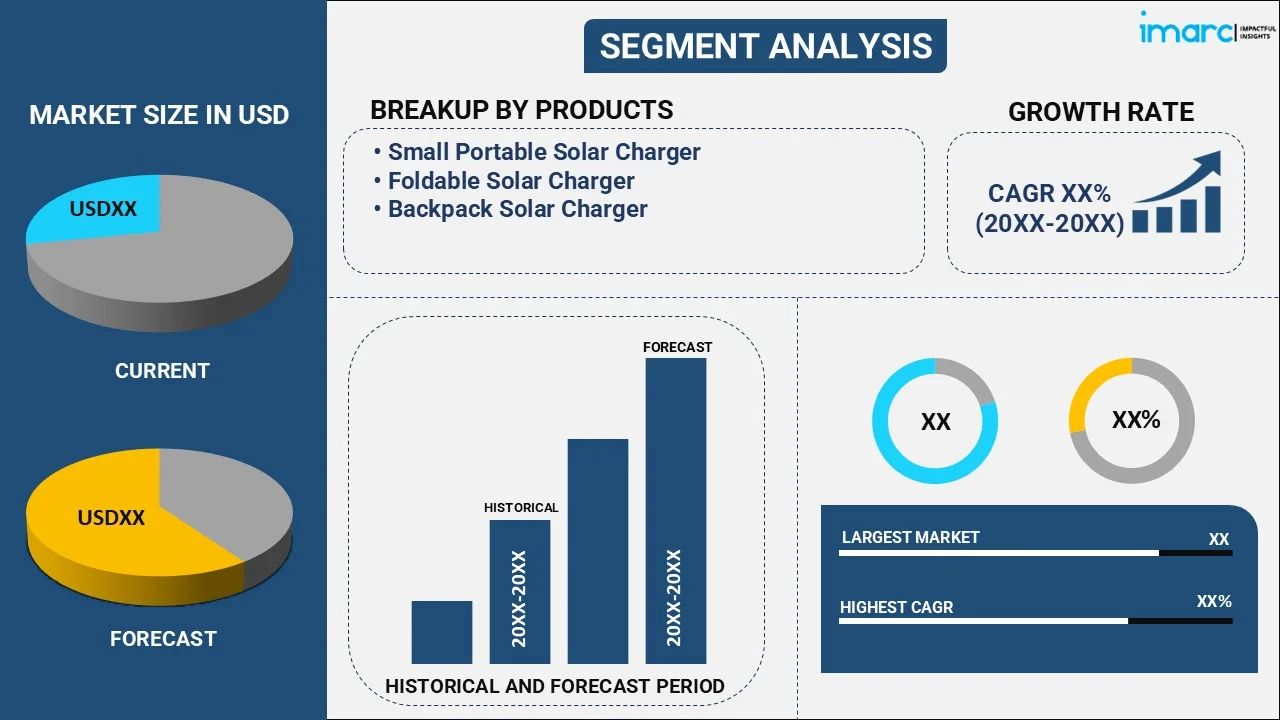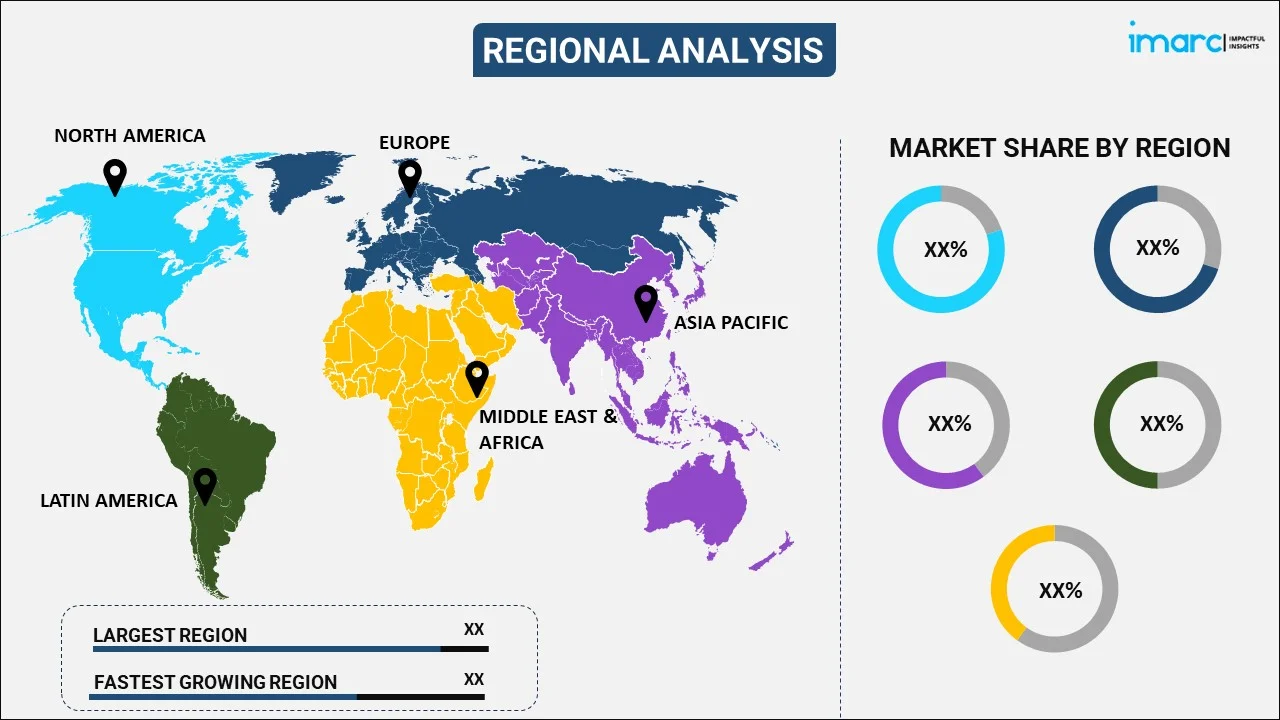
Portable Solar Charger Market Report by Product (Small Portable Solar Charger, Foldable Solar Charger, Backpack Solar Charger), Panel Type (Monocrystalline, Polycrystalline, and Others), Application (Individual, Defense, and Others), and Region 2025-2033
Market Overview:
The global portable solar charger market size reached USD 5.2 Billion in 2024. Looking forward, IMARC Group expects the market to reach USD 22.8 Billion by 2033, exhibiting a growth rate (CAGR) of 16.45% during 2025-2033. The increasing demand for sustainable and renewable energy solutions, the rising use of smartphones, tablets, smartwatches, and other portable electronic devices, and the growing outdoor recreational activities are some of the factors propelling the market.
|
Report Attribute
|
Key Statistics
|
|---|---|
|
Base Year
|
2024 |
|
Forecast Years
|
2025-2033
|
|
Historical Years
|
2019-2024
|
| Market Size in 2024 | USD 5.2 Billion |
| Market Forecast in 2033 | USD 22.8 Billion |
| Market Growth Rate (2025-2033) | 16.45% |
A portable solar charger is a compact and versatile device that harnesses solar energy to charge electronic devices like smartphones, tablets, cameras, and more. It consists of solar panels that capture sunlight and convert it into electrical energy stored in an internal battery. The stored energy can then be used to charge various gadgets on the go, making it an ideal solution for outdoor enthusiasts, travelers, and individuals in remote areas. It offers the convenience of sustainable charging, reducing the dependence on traditional electricity sources and minimizing the environmental impact. It is lightweight and easily transportable, making it an essential addition to backpacks, camping gear, and emergency kits. With the increasing focus on renewable energy and eco-friendly practices, this charger has gained popularity among eco-conscious consumers. As technology advances, these chargers become more efficient and affordable, making them a practical and environmentally responsible choice for powering electronic devices anytime, anywhere.

The market is experiencing rapid growth due to several key factors that have boosted its popularity and adoption worldwide. Consumers are seeking eco-friendly alternatives for their power needs with an increasing emphasis on sustainability and reducing carbon footprints. These chargers offer a clean and renewable energy solution, aligning with the global push towards greener technologies. Furthermore, the widespread use of smartphones, tablets, and other portable electronic devices has grown, leading to a higher demand for reliable and accessible charging options. These chargers provide a convenient and self-sustaining solution, enabling users to charge their gadgets even in remote locations. Ongoing technological innovations in solar panels have significantly improved efficiency and reduced costs. Higher conversion rates and enhanced energy storage capabilities have made chargers more practical and appealing to consumers. Moreover, the rise in outdoor activities, camping, and travel has fueled the product demand. Adventure seekers and travelers appreciate the convenience of a portable solar charger, ensuring their devices remain charged during excursions in remote areas without access to conventional power outlets. Besides, these chargers have become an essential part of emergency preparedness kits. In natural disasters or power outages, they provide a reliable backup power source for communication devices and emergency equipment. Supportive government policies and incentives promoting renewable energy adoption have encouraged consumers to invest in portable solar chargers. Tax credits and subsidies offered by some regions further stimulate market growth. Additionally, as the cost of solar panels continues to decline, these chargers have become more affordable and accessible to a broader consumer base, fueling the market. Several manufacturers are continuously introducing new features and designs, such as lightweight and foldable chargers, with enhanced portability and functionality, attracting more users to embrace portable solar solutions.
Portable Solar Charger Market Trends/Drivers:
Increasing need for energy access in remote and off-grid areas
The increasing need for energy access in remote and off-grid areas is catalyzing the market. Several regions worldwide, especially in developing countries, lack reliable access to electricity due to limited infrastructure. These chargers offer a practical and cost-effective solution to this energy gap. In rural and off-grid communities, where traditional power sources are inaccessible or uneconomical, these chargers provide a lifeline for charging essential electronic devices like mobile phones and lights. These chargers empower individuals in remote areas to stay connected, access information, and engage in economic activities, contributing to their socio-economic development. As governments and non-profit organizations focus on bridging the energy divide, the demand for the product is set to grow significantly.
Rising integration of power banks and energy storage capabilities
The integration of power banks and energy storage capabilities into these chargers is bolstering the market. Power banks allow users to store excess solar energy generated during sunny periods and use it later when sunlight is unavailable or insufficient. This feature provides users a reliable and continuous power source, regardless of weather conditions. The convenience of storing energy for later use enhances the practicality and appeal of these chargers, making them a more dependable power solution for outdoor enthusiasts, travelers, and emergencies. Moreover, power banks enable charging at night, ensuring an uninterrupted power supply and broadening the charger's application beyond daytime use. As battery technologies continue to improve, the integration of efficient and high-capacity power banks into these chargers is expected to become more prevalent, further propelling the market.
Growing adoption in disaster relief and humanitarian efforts
The utilization of these chargers in disaster relief and humanitarian efforts has emerged as a critical factor in strengthening the market. During natural disasters and humanitarian crises, access to electricity is often disrupted, making communication and coordination challenging. Portable solar chargers are crucial in such situations by enabling rescue workers, volunteers, and affected communities to charge their communication devices and stay connected. Aid organizations, governments, and NGOs increasingly rely on these chargers as part of their emergency response kits, ensuring efficient communication and coordination during critical times. As the frequency and intensity of natural disasters increase due to climate change, the demand for reliable and self-sustaining power solutions is expected to rise, driving market growth in the disaster relief and humanitarian sectors.
Portable Solar Charger Industry Segmentation:
IMARC Group provides an analysis of the key trends in each segment of the portable solar charger market report, along with forecasts at the global, regional and country levels for 2025-2033. Our report has categorized the market based on product, panel type, and application.
Breakup by Product:

- Small Portable Solar Charger
- Foldable Solar Charger
- Backpack Solar Charger
Small portable solar charger dominates the market
The report has provided a detailed breakup and analysis of the market based on the product. This includes a small portable solar charger, foldable solar charger, and backpack solar charger. According to the report, small portable solar charger represented the largest segment.
Small portable solar chargers are compact and lightweight devices designed for convenient on-the-go charging of smaller electronic devices like smartphones, cameras, and portable speakers. They are highly portable and often come with built-in power banks for energy storage, allowing users to charge their devices even when sunlight is unavailable. They are ideal for outdoor enthusiasts, travelers, and individuals seeking a reliable power source for their essential gadgets during their daily activities.
On the contrary, the foldable solar chargers feature multiple solar panels that can be folded and unfolded for easy transportation and storage. These chargers offer larger solar panels and higher power output than small portable chargers, making them suitable for charging a wider range of devices, including tablets and laptops. They are designed for campers, hikers, and travelers who require a higher charging capacity and desire a more versatile charging solution.
Moreover, the backpack solar chargers integrate solar panels directly into the backpack's design, enabling users to charge their devices while moving. These chargers are equipped with larger solar panels, providing ample energy to charge multiple devices simultaneously. They are particularly popular among outdoor adventurers and long-distance travelers who want a hands-free and efficient way to charge their devices during extended journeys.
Breakup by Panel Type:
- Monocrystalline
- Polycrystalline
- Others
Monocrystalline dominates the market
The report has provided a detailed breakup and analysis of the market based on the panel type. This includes monocrystalline, polycrystalline, and others. According to the report, monocrystalline represented the largest segment.
Monocrystalline solar panels are made from single-crystal silicon, making them highly efficient and providing a higher power output per square meter than polycrystalline panels. They have a uniform black color and are known for their sleek design and compactness. They are preferred by users who prioritize efficiency and portability. These chargers are ideal for limited space, such as backpacking or hiking trips, as they can generate more power in a smaller footprint.
Moreover, polycrystalline solar panels are made from multiple silicon crystals, resulting in a lower efficiency than monocrystalline panels. However, polycrystalline panels are more cost-effective to produce, making them a budget-friendly option for portable solar chargers. They typically have a blueish hue and are slightly larger and bulkier than monocrystalline panels. These chargers are favored by users who prioritize affordability and are ideal for camping or outdoor activities where space constraints are less critical.
Breakup by Application:
- Individual
- Defense
- Others
Individual dominates the market
The report has provided a detailed breakup and analysis of the market based on the application. This includes individual, defense, and others. According to the report, individual represented the largest segment.
Individuals extensively use portable solar chargers for personal charging needs. Whether outdoor enthusiasts engage in camping, hiking, or backpacking trips, or travelers, individuals rely on these chargers to keep their electronic devices powered and connected. The convenience and portability of these chargers make them an essential accessory for individuals seeking a reliable and sustainable power source during their adventures or daily activities.
On the contrary, these chargers have found applications in defense and military operations. Soldiers and personnel deployed in remote or off-grid locations require a reliable power source to charge communication devices, night vision equipment, and other critical electronics. These chargers offer a lightweight and self-sustaining solution, ensuring a continuous power supply for defense personnel during missions and operations. They enhance mobility and reduce dependency on conventional power sources in challenging environments, making them an essential component of modern military equipment.
Breakup by Region:

- North America
- United States
- Canada
- Europe
- Germany
- France
- United Kingdom
- Italy
- Spain
- Others
- Asia Pacific
- China
- Japan
- India
- South Korea
- Australia
- Indonesia
- Others
- Latin America
- Brazil
- Mexico
- Others
- Middle East and Africa
Asia Pacific exhibits a clear dominance, accounting for the largest portable solar charger market share
The report has also provided a comprehensive analysis of all the major regional markets, which include North America (the United States and Canada); Europe (Germany, France, the United Kingdom, Italy, Spain, and others); Asia Pacific (China, Japan, India, South Korea, Australia, Indonesia, and others); Latin America (Brazil, Mexico, and others); and the Middle East and Africa.
Asia Pacific is a key market driven by several factors. The region's increasing focus on sustainability and renewable energy solutions has increased demand for eco-friendly charging options. Additionally, the region consumers' popularity of outdoor activities, such as camping and hiking, has boosted the adoption of these chargers for convenient and reliable power. Moreover, government initiatives promoting clean energy and incentives for renewable technologies further support the market growth across the region.
On the contrary, Europe is another significant market, particularly in countries with strong environmental consciousness and renewable energy targets. The market is characterized by a high level of awareness about the environmental benefits of solar energy, driving consumers to opt for sustainable charging solutions. Furthermore, the popularity of travel and tourism in Europe has increased demand for these chargers among travelers and outdoor enthusiasts seeking off-grid power options. European governments' support for solar and clean energy initiatives also contributes to the market's growth.
Competitive Landscape:
Top companies are fostering growth through continuous innovation and product development. They invest in research and development to enhance their chargers' efficiency, portability, and functionality, making them more appealing to consumers. These companies also focus on integrating advanced battery technologies to improve energy storage capabilities, ensuring reliable power supply even in low-light conditions. Moreover, top companies establish strategic partnerships with distribution channels, retailers, and e-commerce platforms to expand their market reach and make these chargers more accessible to a wider audience. By emphasizing environmental sustainability and promoting eco-friendly solutions, these companies are raising awareness about the product's benefits, further catalyzing the market. Additionally, their commitment to quality, reliability, and customer satisfaction fosters trust among consumers, encouraging repeat purchases and positive word-of-mouth referrals, contributing to the overall market expansion.
The report has provided a comprehensive analysis of the competitive landscape in the portable solar charger market. Detailed profiles of all major companies have also been provided.
- Anker Innovations
- FlexSolar
- Goal Zero
- iceTECH USA
- Nekteck
- Powertraveller International Ltd
- Renogy
- Suntactics
- Voltaic Systems
Portable Solar Charger Market Report Scope:
| Report Features | Details |
|---|---|
| Base Year of the Analysis | 2024 |
| Historical Period | 2019-2024 |
| Forecast Period | 2025-2033 |
| Units | Billion USD |
| Scope of the Report | Exploration of Historical and Forecast Trends, Industry Catalysts and Challenges, Segment-Wise Historical and Predictive Market Assessment:
|
| Products Covered | Small Portable Solar Charger, Foldable Solar Charger, Backpack Solar Charger |
| Panel Types Covered | Monocrystalline, Polycrystalline, Others |
| Applications Covered | Individual, Defense, Others |
| Regions Covered | North America, Europe, Asia Pacific, Latin America, Middle East and Africa |
| Countries Covered | United States, Canada, Germany, France, United Kingdom, Italy, Spain, China, Japan, India, South Korea, Australia, Indonesia, Brazil, Mexico |
| Companies Covered | Anker Innovations, FlexSolar, Goal Zero, iceTECH USA, Nekteck, Powertraveller International Ltd, Renogy, Suntactics, Voltaic Systems, etc. |
| Customization Scope | 10% Free Customization |
| Post-Sale Analyst Support | 10-12 Weeks |
| Delivery Format | PDF and Excel through Email (We can also provide the editable version of the report in PPT/Word format on special request) |
Key Benefits for Stakeholders:
- IMARC’s report offers a comprehensive quantitative analysis of various market segments, historical and current market trends, market forecasts, and dynamics of the portable solar charger market from 2019-2033.
- The research study provides the latest information on the market drivers, challenges, and opportunities in the portable solar charger market.
- The study maps the leading, as well as the fastest-growing, regional markets. It further enables stakeholders to identify the key country-level markets within each region.
- Porter's five forces analysis assists stakeholders in assessing the impact of new entrants, competitive rivalry, supplier power, buyer power, and the threat of substitution. It helps stakeholders to analyze the level of competition within the global portable solar charger industry and its attractiveness.
- Competitive landscape allows stakeholders to understand their competitive environment and provides an insight into the current positions of key players in the market.
Key Questions Answered in This Report
The portable solar charger market was valued at USD 5.2 Billion in 2024.
The portable solar charger market is projected to exhibit a CAGR of 16.45% during 2025-2033.
The portable solar charger market is driven by the increasing demand for eco-friendly and sustainable energy solutions. As consumers seek off-grid power options for outdoor activities and emergencies, solar chargers offer a convenient, renewable energy source. Advancements in solar panel efficiency and battery storage technology enhance product performance. Additionally, rising awareness of climate change and the growing trend of adopting clean energy solutions further boost the market for portable solar chargers.
Asia Pacific currently dominates the market driven by the increasing focus on sustainability and renewable energy solutions along with the popularity of outdoor activities, such as camping and hiking.
Some of the major players in the portable solar charger market include Anker Innovations, FlexSolar, Goal Zero, iceTECH USA, Nekteck, Powertraveller International Ltd, Renogy, Suntactics, Voltaic Systems, etc.
Need more help?
- Speak to our experienced analysts for insights on the current market scenarios.
- Include additional segments and countries to customize the report as per your requirement.
- Gain an unparalleled competitive advantage in your domain by understanding how to utilize the report and positively impacting your operations and revenue.
- For further assistance, please connect with our analysts.
 Inquire Before Buying
Inquire Before Buying
 Speak to an Analyst
Speak to an Analyst
 Request Brochure
Request Brochure
 Request Customization
Request Customization




.webp)




.webp)












